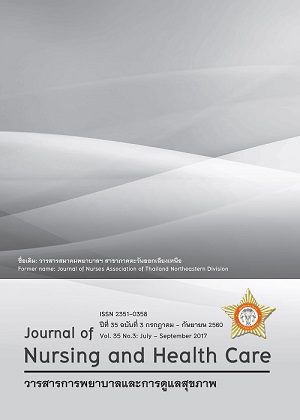ความสัมพันธ์ระหว่างกลุ่มอาการไม่พึงประสงค์และคุณภาพชีวิตในผู้ป่วยโรคไตเรื้อรัง Relationship Between Unpleasant Symptom Clusters And Quality of Life Among Patients With Chronic Kidnet Disease
คำสำคัญ:
โรคไตเรื้อรัง กลุ่มอาการไม่พึงประสงค์ คุณภาพชีวิต chronic kidney disease unpleasant symptom clusters quality of lifeบทคัดย่อ
บทคัดย่อ
การวิจัยครั้งนี้เป็นการวิจัยเชิงพรรณนา เพื่อศึกษาความสัมพันธ์ระหว่างกลุ่มอาการไม่พึงประสงค์และคุณภาพชีวิตในผู้ป่วยโรคไตเรื้อรัง โดยใช้ทฤษฎีอาการไม่พึงประสงค์ (Theory of Unpleasant Symptoms) เป็นกรอบแนวคิด กลุ่มตัวอย่างเป็นผู้ป่วยโรคไตเรื้อรังระยะที่ 3-4 ที่มารับบริการที่คลินิกผู้ป่วยนอก โรงพยาบาลระดับตติยภูมิแห่งหนึ่งในจังหวัดร้อยเอ็ด ระหว่างเดือนมกราคม-มีนาคม 2559 ถูกคัดเลือกแบบเจาะจงจำนวน 150 ราย เก็บรวบรวมข้อมูลโดยใช้แบบบันทึกข้อมูลทั่วไป แบบประเมินอาการไม่พึงประสงค์ และแบบประเมินคุณภาพชีวิตทั่วไป วิเคราะห์ข้อมูลด้วยสถิติเชิงพรรณนา สถิติวิเคราะห์องค์ประกอบ และสถิติสหสัมพันธ์ กำหนดค่านัยสำคัญทางสถิติที่ .05
ผลการวิจัยพบอาการไม่พึงประสงค์ 28 อาการ อาการไม่พึงประสงค์ที่มีการรับรู้มากที่สุดคือ ชาปลายมือปลายเท้า อาการทั้งหมดจัดเป็นกลุ่มอาการไม่พึงประสงค์ได้ 8 กลุ่ม สามารถอธิบายความแปรปรวนได้ร้อยละ 52.56 กลุ่มอาการทางจิตใจและอารมณ์มีการรับรู้ความรุนแรงสูงสุดและมีความสัมพันธ์ทางลบกับคุณภาพชีวิตสูงสุดทั้งโดยรวมและรายด้าน กลุ่มอาการที่เหลือยกเว้นกลุ่มอาการระบบทางเดินปัสสาวะ มีความสัมพันธ์ทางลบกับคุณภาพชีวิตด้านสุขภาพกาย
พยาบาลควรนำผลวิจัยนี้มาใช้วางแผนดูแลผู้ป่วยโรคไตเรื้อรังที่มีกลุ่มอาการไม่พึงประสงค์เพราะกลุ่มอาการเหล่านี้อาจทำให้คุณภาพชีวิตของผู้ป่วยเลวลง
Abstract
This descriptive correlation research aimed to identify the relationship between unpleasant symptom clusters and quality of life among patients with chronic kidney disease (CKD). The theory of Unpleasant Symptoms was used as the conceptual framework. The study participants consisted of 150 patients with stage 3 to 4 CKD who were treated at CKD clinic of one tertiary hospital in Roi-et province, Thailand and were chosen purposively. Data collection was conducted during January, 2016 to March, 2016 by using three forms of patient general information, the CKD unpleasant symptoms, and SF-36. Descriptive statistics, factor analysis and multiple correlation were used to analyze the data. Statistical significance was set at .05
The results revealed that patients with CKD stage 3-4 had 28 unpleasant symptoms. The most frequently perceived were limbs numbness. The 28 unpleasant symptoms could be grouped into 8 clusters with 52.56% explanatory variance. Among 8 symptom clusters, psychological and emotional cluster was found to have the greatest severity and the strongest negative correlation with all aspect of QOL. Negative correlations were also found between the remaining symptom clusters, except the urinary tract cluster, and physical component of QOL.
Nurses should address the finding of this study in planning and taking care of CKD patients with unpleasant symptom clusters since they may deteriorate QOL of the patients.



